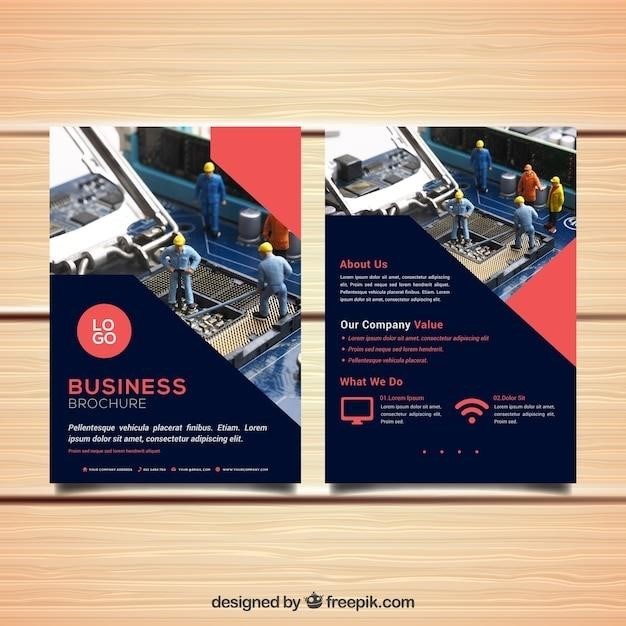Jeep Wrangler Instruction Manual⁚ A Comprehensive Guide
This comprehensive guide will walk you through everything you need to know about your Jeep Wrangler, from its powerful engine options to its impressive off-road capabilities․ We’ll cover essential information about safety features, top options, maintenance, troubleshooting, and more․ Whether you’re a seasoned Wrangler owner or a first-time buyer, this manual will equip you with the knowledge to enjoy your Jeep to the fullest․
Introduction
Welcome to the world of the Jeep Wrangler, a vehicle synonymous with adventure, freedom, and rugged capability․ This instruction manual is your comprehensive guide to understanding and operating your Wrangler, ensuring you get the most out of its features and capabilities․ Whether you’re traversing challenging off-road terrain or cruising down city streets, this manual will provide you with the knowledge and insights to safely and confidently navigate any adventure․
The Jeep Wrangler is more than just a vehicle; it’s an experience․ Its iconic design, open-air capability, and robust performance have captivated drivers for generations․ This instruction manual is designed to deepen your understanding of your Wrangler, empowering you to make informed decisions and maximize your driving experience․ From understanding the intricacies of its engine and transmission options to mastering its safety features, this guide will be your trusted companion on the road ahead․
Throughout this manual, you will find detailed explanations, clear illustrations, and helpful tips that will enhance your understanding of your Wrangler’s features and functionality․ We encourage you to read through the entire manual, paying close attention to the safety precautions and maintenance recommendations․ By following these guidelines, you can ensure the longevity and optimal performance of your Jeep Wrangler, allowing you to embark on countless adventures with confidence․
Engine and Transmission Options
The Jeep Wrangler offers a range of engine and transmission options, each designed to deliver the power and performance you need for your adventures․ Let’s explore the available choices and their characteristics⁚
The standard engine for the 2025 Jeep Wrangler is the 3․6-liter V-6, which produces a respectable 285 horsepower․ This engine is paired with a six-speed manual transmission, offering a classic driving experience and greater control, especially for off-road enthusiasts․ While the eight-speed automatic transmission is no longer available with the standard V-6, it’s still available on other engine options․
For those seeking even more power, the Wrangler offers a turbocharged 2․0-liter four-cylinder engine that delivers 270 horsepower and 295 lb-ft of torque․ This engine comes standard with an eight-speed automatic transmission, providing smooth acceleration and efficient fuel economy․ The eight-speed automatic transmission is also available with the optional 3․6-liter V-6 engine․
The Jeep Wrangler also offers a powerful 3․6-liter Pentastar V-6 engine that produces 285 horsepower and 260 lb-ft of torque, paired with an eight-speed automatic transmission․ This combination offers a balance of power and efficiency, making it suitable for both on-road driving and off-road excursions․
The Wrangler also has a 3․0-liter EcoDiesel V-6 engine option․ This engine generates 260 horsepower and a substantial 442 lb-ft of torque, providing exceptional pulling power and fuel efficiency․ The EcoDiesel engine is paired with an eight-speed automatic transmission, ensuring smooth and responsive performance․
Safety Features
The Jeep Wrangler is renowned for its off-road prowess, but it also prioritizes the safety of its occupants․ The vehicle is equipped with a comprehensive suite of standard and optional safety features, designed to provide peace of mind on every journey․
As of the 2025 model year, every Jeep Wrangler comes standard with power locks and power windows, enhancing convenience and security․ These features contribute to a safer driving experience by allowing you to easily lock and unlock your vehicle and control the windows for better ventilation․
The Wrangler’s safety features go beyond basic conveniences; Standard safety features include advanced airbags, including front, side, and curtain airbags, which provide protection in the event of a collision․ Electronic stability control (ESC) helps maintain vehicle stability during challenging driving conditions, while anti-lock brakes (ABS) enhance braking performance and control․ The Wrangler also features a tire pressure monitoring system (TPMS) that alerts you to low tire pressure, potentially preventing dangerous situations․
Optional safety features further enhance the Wrangler’s protection․ Advanced Driver-Assistance Systems (ADAS) are available, including blind-spot monitoring, rear cross-traffic alert, and adaptive cruise control․ These systems utilize sensors and cameras to provide warnings and assistance, helping you to stay aware of your surroundings and avoid potential hazards․
The Jeep Wrangler’s combination of standard and optional safety features makes it a safe and reliable vehicle for both on-road and off-road adventures․ By understanding and utilizing these features, you can enjoy a secure and enjoyable driving experience․
Top Options and Installation
One of the hallmarks of the Jeep Wrangler is its extensive array of top options, allowing you to customize your vehicle for any adventure․ From traditional soft tops to modern hard tops, each top offers unique benefits and a distinct look․ Understanding the different top options and their installation process is crucial for enjoying your Wrangler to the fullest․
The most popular top option for the Jeep Wrangler is the soft top․ Soft tops are known for their ease of removal and storage, making them ideal for enjoying open-air driving during warmer months․ They come in various materials, including fabric, vinyl, and even denim, offering different levels of durability and weather resistance․ Installation of a soft top typically involves securing the top to the windshield frame and then attaching it to the rear of the vehicle․ Detailed instructions are usually provided with the top, and many online resources offer helpful guides and videos․
For those seeking more weather protection and a more permanent roof solution, hard tops are a popular choice․ Hard tops are typically made of fiberglass or steel, offering a more rigid and durable construction․ They are also available in various colors and styles, allowing you to personalize your Wrangler’s appearance․ Hard top installation is generally more involved than soft top installation, often requiring specialized tools and knowledge․ It’s recommended to consult a professional for installation to ensure a proper fit and safe operation․
Regardless of your top choice, it’s essential to follow the manufacturer’s instructions carefully during installation․ Proper installation is crucial for ensuring the top’s functionality and safety․ Regular maintenance and cleaning are also recommended to maintain your top’s performance and appearance․

Maintenance and Servicing
Ensuring your Jeep Wrangler remains in top condition requires a dedicated maintenance and servicing schedule․ Regular upkeep not only extends the life of your vehicle but also guarantees optimal performance and safety․ This section outlines essential maintenance tasks and the importance of adhering to your Jeep Wrangler’s service intervals․
One of the most crucial aspects of Jeep Wrangler maintenance is oil changes․ The engine oil lubricates moving parts, preventing wear and tear․ Following the manufacturer’s recommended oil change intervals, typically every 5,000-7,500 miles, is essential for engine health․ Other routine maintenance tasks include air filter replacement, spark plug replacement, brake fluid checks, and tire rotations․ These tasks help ensure your Wrangler runs smoothly and efficiently․
Beyond routine maintenance, your Jeep Wrangler also requires scheduled servicing at specific intervals․ These services involve more comprehensive inspections and potential repairs, including fluid changes, belt and hose inspections, and component checks․ Adhering to the service schedule outlined in your owner’s manual is crucial for identifying and addressing potential issues before they escalate into major problems․
Regularly checking your Jeep Wrangler’s fluids is another essential part of maintenance․ Fluids such as engine coolant, brake fluid, power steering fluid, and transmission fluid play vital roles in your vehicle’s operation․ Ensure these fluids are at the correct levels and in good condition to prevent potential issues․ Additionally, inspecting your Wrangler’s tires for wear and tear, checking tire pressure, and ensuring proper inflation are crucial for safe and optimal performance․
Troubleshooting and Repairs
While the Jeep Wrangler is renowned for its durability and reliability, occasional issues can arise․ This section provides guidance on troubleshooting common problems and understanding when professional repairs are necessary․ Knowing how to identify and address simple issues can save you time and money in the long run․
One common problem encountered by Wrangler owners is a dead battery․ If your Wrangler won’t start, check the battery terminals for corrosion and ensure they are securely connected․ If the battery is old or shows signs of damage, consider replacing it․ Another frequent issue is a malfunctioning starter․ A clicking sound when trying to start the engine often indicates a faulty starter․ Seek professional assistance for starter repairs․
Electrical issues can also arise in your Wrangler․ If lights, power windows, or other electrical components stop working, check the fuses․ A blown fuse can be easily replaced․ However, if electrical problems persist, it’s advisable to consult a qualified mechanic to diagnose and resolve the issue․ Additionally, if your Wrangler’s engine is experiencing a loss of power or erratic performance, it’s crucial to investigate potential causes such as a clogged air filter, faulty spark plugs, or a problem with the fuel system․
Understanding the basics of troubleshooting can help you identify and address minor issues, but for complex repairs, it’s essential to seek professional assistance․ A qualified mechanic can accurately diagnose problems and perform necessary repairs using specialized tools and knowledge․ Always refer to your owner’s manual for specific troubleshooting tips and warnings related to your Jeep Wrangler model․
Towing and Off-Road Capabilities
The Jeep Wrangler is renowned for its off-road prowess, but its capabilities extend beyond conquering rugged terrain․ With proper preparation, your Wrangler can also serve as a reliable towing vehicle․ Understanding the towing capacity of your specific Wrangler model is crucial․ Refer to your owner’s manual for detailed information on towing limits and recommended towing practices․ Always ensure that the weight of the trailer and its contents does not exceed the vehicle’s maximum towing capacity․
Towing safely requires the use of appropriate equipment․ A properly fitted trailer hitch and safety chains are essential․ Consider using a brake controller for trailers exceeding a certain weight․ This device helps control the trailer’s brakes, enhancing safety during towing․ When towing, be mindful of the increased stopping distance and handling changes․ Avoid aggressive maneuvers and maintain a safe following distance․
The Jeep Wrangler is a natural off-roader, boasting impressive ground clearance, four-wheel drive, and optional features like locking differentials․ Before venturing off-road, it’s vital to assess the terrain and prepare accordingly․ Check tire pressure and ensure that the vehicle is equipped with appropriate tires for the conditions․ Invest in recovery gear such as a winch, tow straps, and a shovel, as these can be invaluable in case of unexpected situations․ Familiarize yourself with off-road driving techniques and practice them in a controlled environment․ Remember, off-road driving can be challenging and requires responsible decision-making to ensure a safe and enjoyable experience․
Warranty and Support
Your Jeep Wrangler comes with a comprehensive warranty that protects you against defects in materials and workmanship․ Understanding the terms and conditions of your warranty is essential for safeguarding your investment․ The standard warranty typically covers the powertrain for a longer duration than the basic warranty, providing peace of mind for major components like the engine and transmission․ Additionally, Jeep offers optional extended warranties that can provide further coverage beyond the standard terms․
Jeep’s commitment to customer support extends beyond the warranty․ A vast network of authorized dealerships provides access to trained technicians who are equipped to handle routine maintenance and complex repairs․ These dealerships carry genuine Jeep parts, ensuring the highest quality for your vehicle․ For any inquiries or concerns, you can contact Jeep customer service directly through their website or phone line․ Their dedicated team is available to assist you with any questions or issues you may encounter․
Maintaining a comprehensive record of your vehicle’s service history is crucial․ Keep track of all maintenance appointments, repairs, and any warranty-related work․ This documentation can be invaluable if you need to make a claim or need to sell your Jeep in the future․ By understanding your warranty and utilizing the resources provided by Jeep, you can ensure that your Wrangler receives the proper care and support throughout its lifespan․


